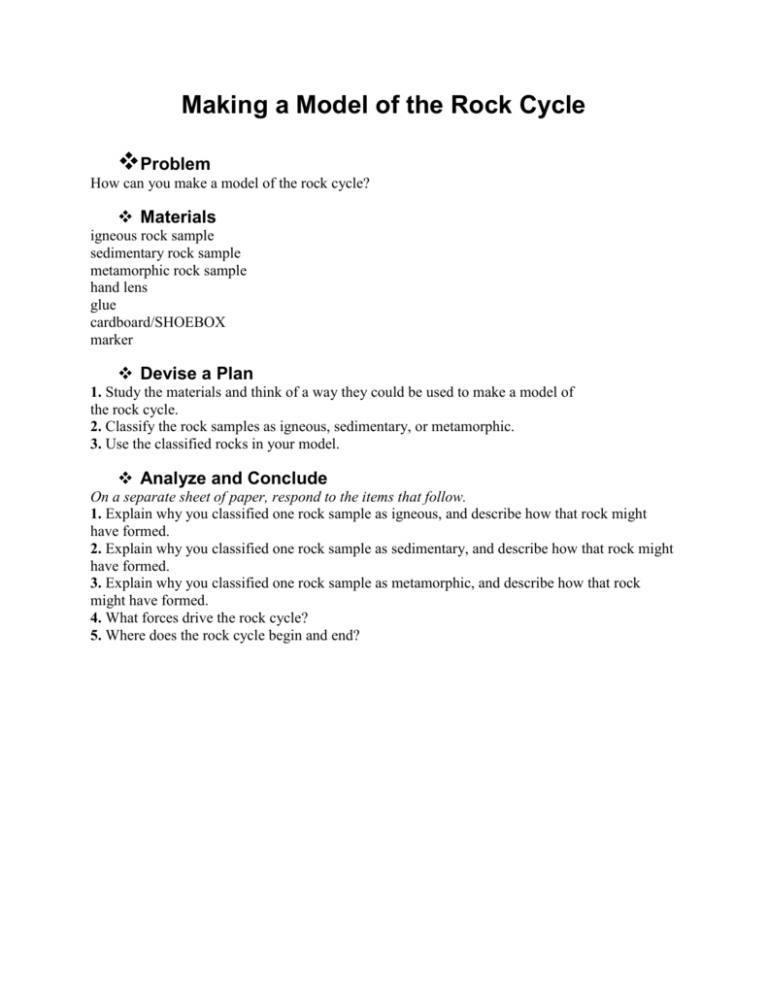Making a Model of the Rock Cycle
advertisement

Making a Model of the Rock Cycle Problem How can you make a model of the rock cycle? Materials igneous rock sample sedimentary rock sample metamorphic rock sample hand lens glue cardboard/SHOEBOX marker Devise a Plan 1. Study the materials and think of a way they could be used to make a model of the rock cycle. 2. Classify the rock samples as igneous, sedimentary, or metamorphic. 3. Use the classified rocks in your model. Analyze and Conclude On a separate sheet of paper, respond to the items that follow. 1. Explain why you classified one rock sample as igneous, and describe how that rock might have formed. 2. Explain why you classified one rock sample as sedimentary, and describe how that rock might have formed. 3. Explain why you classified one rock sample as metamorphic, and describe how that rock might have formed. 4. What forces drive the rock cycle? 5. Where does the rock cycle begin and end? Idea for building a Rock Cycle (be very creative) Things you need Rock samples Sturdy cardboard Hot glue gun OR glue Glue sticks Permanent markers Gather Rock Samples 1. Granite is an igneous rock used in construction and landscaping. Obtain three to five small samples of igneous rock from a school supply store or local craft store. Igneous rocks are formed when hot, liquid magma cools and hardens. Purchase samples such as obsidian, pumice or granite. 2. Sandstone is known for its beauty and is used for countertops and tiles. Purchase three to five small samples of sedimentary rock. Sedimentary rock forms when rocks and minerals are broken down in a process called weathering. Layers are formed when weathered rock and plant and animal remains are pressed together over time. Gather samples such as breccia, sandstone or shale. 3. Gneiss is metamorphic rock that is used as decorative stone. Pick out three to five metamorphic rock samples. Metamorphic rock forms when heat and pressure are applied to igneous or sedimentary rock, causing changes in shape and appearance. These are samples such as gneiss, marble or slate. Assemble the Model 1. Cut an 18-inch by 18-inch square out of the side of a sturdy cardboard box. Lightly trace a large circle onto the square. Use a ruler and a pencil to divide the circle into 10 equal sections. 2. Write the word "magma" in the top, middle section of the circle using a black permanent marker. Move in a counterclockwise fashion as you put together your rock cycle model. Draw a curved arrow that points to the next section of the circle. 3. Label the second section of the circle with the word "crystallization" with a coloured marker. Label the third section "igneous rock," using a black marker. Use a hot glue gun/adhesive to attach the igneous rocks that you have chosen for the display. 4. Title the fourth section "weathering, erosion and deposition." Write "sediment" with a black marker in the fifth section. Use a coloured marker to write "compaction and cementation" in the sixth section. Glue the sedimentary rocks onto the seventh section and label it "sedimentary rock" at the top with a black marker. 5. Write the words "heat and pressure," using a coloured marker, at the top of the eighth section. Label the ninth section "metamorphic rock," using a black marker and glue the metamorphic rock samples onto this section. Use a coloured marker to write the word "melting" in the tenth and final section. Use a black marker to draw short curved arrows to connect each section of the rock cycle model.







